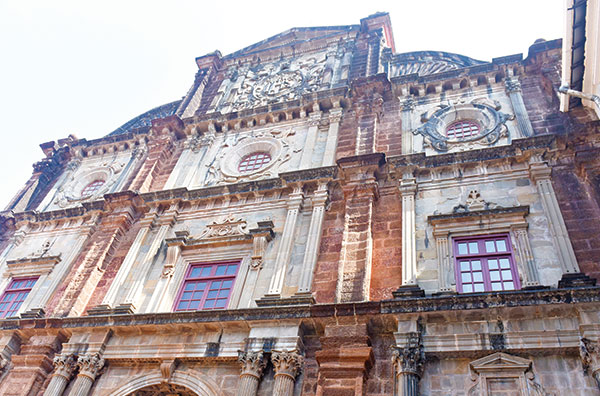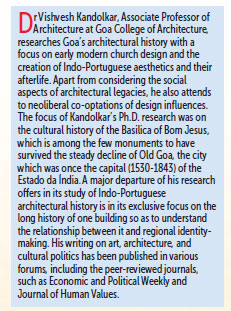
‘Within a few moreHERALD: What are the problems facing the structure of the Basilica since you took over as rector?
Fr Patricio Fernandes: Of the many problems facing the structure of the Basilica, the most urgent problem to be attended to in my opinion is the unplastered laterite walls of the Basilica. The exposed laterite stones on the exterior of the Basilica on the East, North and West are badly worn out in practically all the places over the years. However, in some places they are extremely worn out, especially where the wind and rain lashes at it during the monsoons. There are other elements that contribute to this deterioration, namely the type of laterite stone used in those places.
The Basilica was inaugurated in 1605 complete with lime plaster and whitewash. It was only in the early 1950s that the plaster was removed on the three sides to make it appear more ‘ancient’ so as to symbolize the longevity of the Portuguese presence in India. This ‘false restoration’ was a failure because the laterite stone began to deteriorate which started affecting the structure and the walls inside. Within ten years a plan was put in place for the Basilica to be re-plastered, but it never happened. Just imagine the colossal damage from leaving it exposed for 60 long years in addition to the initial decade when it started deteriorating. It’s simply terrible! Disastrous!! Within a few more years, the structure will collapse in certain parts because the laterite stone has become brittle and will ultimately give way. If this process is not stopped, then when the Basilica will fall apart, any day, is anybody’s guess.
HERALD: Has the problem of dampness of walls increased this year?
PF: Within a span of ten years of my tenure at the Basilica, I have seen the worst ever soaking of the inside walls of the Basilica. The laterite stones get saturated with the torrential rainwater, and the walls are soaked so much that the water starts dripping through the inside walls. Of all the years of the dampness occurring, this year the deterioration is starkly the worst.
HERALD: What effect has the dampness had on the Basilica?
PF: Because of COVID-19, the Basilica remained deserted. But inside the Basilica it was musty. It looked very frightening. Since the Basilica has a lot of furniture, wooden statues, pulpits and gilded altars, I am afraid that the already existing activity of the termites and other wood burrowing insects, will attack the wood even more relentlessly.
HERALD: Has the Archdiocese and the ASI discussed the issue of the rapid deterioration of the facade?
PF: Coupled with my own observation, many architects and engineers of repute who have shown deep concern for this beautiful architectural masterpiece have voiced out their concern and they have already alerted me to draw the attention of the Archdiocese and the ASI to the rapidly deteriorating condition of the Basilica. Personally, I have made them all aware of the condition of the Basilica and the urgency of acting to save it from one day suddenly collapsing. They have all shown concern, but the direction of the action is awaiting.
HERALD: What is the solution being proposed by the ASI, Archdiocese and other experts to conserve the deteriorating structure of the Basilica?
PF: The ASI South Zone lady director has shown much concern for the deteriorating condition of the Basilica because she has seen it for herself. The ASI Goa Circle is ready for action provided ASI Delhi and South Zone signals the start of the process. Upon my indication, with of course the consent of the Archdiocese, the ASI Goa Circle can then initiate a planned proposal to the ASI South Zone and the ASI Headquarters Delhi. Meanwhile, the Archdiocese is awaiting the studied assessment from the experts, but they are in full support for what is best for the future of the Basilica. The experts, opine that the plastering with lime as it was for three hundred and forty-five years before is a great step in conserving the Basilica for another five hundred years. They also propose that a thorough study of the components of the lime plaster that was earlier used to be analysed in laboratories in Germany and that the same composition should be used for plastering the Basilica again. Dr. António Nunes Pereira, who has done extensive research on the Basilica, is of the opinion that the plastering must be done but also constantly checked and to re-plaster if cracks are formed.
HERALD: What is your personal opinion on re-plastering the Basilicas exterior to its original condition?
PF: Initially, I was not for plastering the Basilica, because I had always seen it in its unplastered form. But over the years, seeing the rapidly deteriorating condition of the structure, and the experts’ conviction regarding the collapse of the Basilica should the plastering be delayed, I too want it to be plastered as soon as we possibly can. Recently, the ASI repaired the South side roof of the Basilica and said it would not leak for 25 years. They were proved wrong because within ten days of the monsoon, the walls began to be drenched in two large areas of the southern wall. The exposed laterite portion of the roof soaked the walls and the water started trickling down. If this carries on without urgently attending to the deteriorating condition of the laterite stones of the Basilica, then the disaster awaits us like a thief in the night. So after these years of observation of the elements of nature acting on the structure of the Basilica, I am convinced that the Basilica should be re-plastered with lime as it was from its inception for it to last another five hundred years. But I would like every other person who is concerned about the future of the Basilica to expose himself/herself to what is happening to it and arrive at their own informed conviction of whether they are for or against re-plastering it.
Bom Jesus: The Living Heritage of Goa and Goans
HERALD: Why does the Basilica of Bom Jesus have an unplastered laterite exterior, something not commonly seen in other churches of Goa?
Vishvesh Kandolkar: Today, a generation of Goans has grown accustomed to seeing the Basilica’s exposed laterite walls, but this is not the way the building was designed, nor indeed the way it looked until about 60 years ago. It was the famous restorer from Portugal, Baltazar da Silva Castro, who in the 1950s brought about the dramatic transformation of the external appearance of the Basilica by having the plaster removed and leaving the underlying laterite stone exposed. Portuguese scholar Joaquim dos Santos states that such de-plastering was part of former Portuguese Prime Minister, António de Oliveira de Salazar’s nationalistic ideology, where monuments in Portugal were falsely ‘restored’ to look ancient, or rather medievalised, to proclaim the antiquity of the Portuguese Empire. Dos Santos further adds that many such ideologically motivated restorations were initially undertaken in Salazar-ruled Portugal during the 1940s to reinforce the nationalistic agenda and to essentially prove through architectural restorations the long lineage of the Portuguese ‘nation’.
In the twentieth century, Portuguese used the strategy of being both, at once an old regime with a long memory of a glorious period of empire building in the sixteenth century and also embracing modernity in keeping step with other nations.In Goa, the aesthetics of Portuguese restorations, which involved the stripping of the skin-like plaster from heritage buildings, could also be seen as part of the general modernist aesthetics of the time in Europe. In her 2011 book, Second Skin, Professor of English and American Studies, Anne Anlin Cheng, suggests that the modernists had a fetish for exposed surfaces, arguing that the “trope of skin/surface [occupied] a central place in the making of modern aesthetic and philosophic theory.”
The Portuguese state’s use of similar surface-focussed aesthetics for Bom Jesus in the 1950s reveals a nominal engagement with modernism; the state continued to hold on to architectural remnants such as the Bom Jesus from the sixteenth century to be simultaneously modern and ancient. Herein lies the dual implication of the de-plastering of Bom Jesus: it mirrored the modernist architectural fascination with the skin/surface of a building, even as it attempted to disrupt the historical narrative of the building by making it appear older than it was. The implication of the surface transformation of Bom Jesus in the 1950s made the Basilicato look different from other Goan churches, because most of them were generally whitewashed.
HERALD: Why has the Archdiocese and the Archaeological Survey of India (ASI) unable to stop the degradation of the Basilica? How grave is the situation of the Basilica today? What are the consequences of leaving the Basilica unplastered?
VK: One consequence of keeping the Basilica exposed for the last 60 odd years is the damage it has caused to the walls of the church. Because the laterite stone is porous, when exposed to rain it absorbs water by capillary action, soaking the entire wall. Further, the exposed surface of the laterite has undergone severe weathering due to heavy rainfall in Goa, leading to the deterioration of the building. The damage that the monument has been sustaining has, moreover, not only been restricted to the exterior surfaces of the building. Recent visit to the church revealed that the interior walls were wet even in December. In fact, it is a miracle that the exposed laterite walls of the Basilica have withstood the onslaught of the Goan monsoon since the 1950s. The same fate was not accorded to the Arch of the Viceroy’s – another monument in Old Goa that was deplastered on the recommendations of restorer Castro in the same period in the 1950s. Sadly, this monument crumbled during heavy monsoon rains that followed and the Arch visible today is a reconstructed version of the original. In fact, as dos Santos maintains, the Portuguese administration became aware of the problems of an un-plastered Basilica and were in the process of rectifying their mistake in 1960. However, before they could execute the work, Goa was integrated within the Indian Union. Thereafter, the reluctance of the Church and the ASI to repair the historical mistake has led to further ruination of the monument.
Most people in the present generation accept the look of the un-plastered Basilica, just because it is this appearance that they have become accustomed to. The clerical authorities in the Archdiocese are aware of the problem but they also continue to believe that the Basilica should remain unplastered fearing opposition from the people.
Although re-plastering the building’s surface would increase its life expectancy by fixing leaks that have deteriorated it, the Basilica continues to remain unplastered because people have been fed a particular (mis)representation of the monument’s appearance in the contemporary moment. In this case, the seeming support for popular sentiment is the product of a lack of awareness about the building’s architectural history which actually hurts its physical integrity. It is important to note that re-plastering and whitewashing the Basilica would not violate the 1964 Charter of Venice for restorations of historic monuments; as such change would be for structural rather than aesthetic reasons.
HERALD: Why do monuments get ruined? In whose interest is it to allow a monument to get ruined?
VK: For the tourism industry, Old Goa has been more marketable as a ruin, as a noun, a place frozen in (Portuguese colonial) time. In her 2013 book, Imperial Debris, Professor of Anthropological and Historical Studies, Ann Laura Stoler suggests that ruination is more than a process that ends up with building debris as a by-product; rather, ruination is also a political and economic project that lays to waste certain people, their relations, and their things that they accumulate in specific places. In rendering particular sites, such as Old Goa, fossils of a bygone era, corporations and the state similarly fossilises the community whose history, culture, and memory include these sites. Even when such sites are recognised and listed as ‘national monuments’ by the ASI, or as a World Heritage Site by UNESCO, it is done not to safeguard the heritage of minority communities, but to provide touristic locations in the service of the neoliberal economy. This is the case with the colonial architecture in Goa, as much as the Goan Catholic culture it represents – both of which have become objectified. Thereupon, people from the rest of India (and the world), who come to visit Goa as a holiday destination look upon churches and congregations through a touristic gaze, as if the place and its people are kept in a museum.
HERALD: What is the architectural importance of the Basilica?
VK: First of all, Bom Jesus is important because it houses the precious relics of St. Francis Xavier (1506-1552). Secondly, the building is also a critical part of the region’s architectural legacy, as it is an evidence of Goa’s rich history in the sixteenth century, when the city became the capital of Estado da Índia, the territory which spanned from Cape of Good Hope in Africa to Macao in China. Apart from being an important religious building complex, whose construction began in 1594, Bom Jesus is one of the first monuments in Goa to have been constructed in the Baroque style using local labour and materials. This church with cruciform layout has a single nave (hall) covered by a simple wooden ceiling. The main chancel (chapel with the main altar) has a coffered vaulted ceiling built with local laterite stone. Apart from the main chancel, the church houses two additional chapels, both located in the alcove of each transept. The church has a classical façade, and unlike many churches in Goa its bell tower is located at the rear end of the complex. In his remarkable 2011 book, Whitewash, Red Stone: A History of Church Architecture in Goa, historian Paulo Varela Gomes argues that while the overall design of the church is a modest affair, the façade stands out as unique in the history of Christian architecture in Asia.
The uniqueness of the façade, which is decorated entirely with imported stone from Bassein, can only be appreciated when rest of the building is whitewashed, as was the case before the 1950s. According to Varela Gomes it is the novelty and modernity of the design articulation of Bom Jesus’s façade that “had a profound impact on Goa’s architectural culture: Flemish ornament, Serlian mouldings, round windows and French Serlian window frames, were subsequently used in simplified form throughout Goa in the 17th and early 18th centuries.” He further states that the lasting contribution of the basilica is that it allowed local artisans “to domesticate European architectural and ornamental vocabulary, to make it their own.” Essentially, not only is the architecture of the Bom Jesus uniquely Goan, but this sixteenth century monument also inspired the emergence of Indo-Portuguese architecture of Goa.
HERALD: What should be done to secure the Basilica for future generations?

VK: Imperative to the conservation of the Basilica is the understanding that such historical and historic buildings may not simply be monuments of the past; rather, they continue to function as part of the living heritage of a community and, therefore, still contribute to their identity-making as Goans. What is special about Bom Jesus is that the community associated with it continues to use the church on a day-to-day basis as a place of worship, even as it is the repository of the remains of the sixteenth-century saint. The church is a part of the lived and living heritage of the local Goan community and the region; it is not a relic of the past alone. Therefore, architectural conservation of the building is of utmost importance and should be done sensitively keeping in mind that the building is part of the living heritage of Goans.
